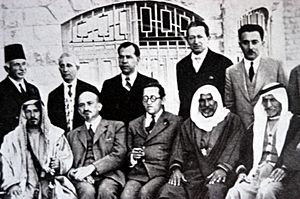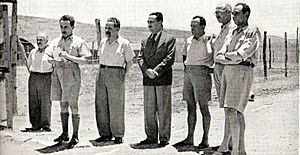Moshe Sharett facts for kids
Quick facts for kids
Moshe Sharett
משה שרת |
|
|---|---|

Sharett in 1952
|
|
| 2nd Prime Minister of Israel | |
| In office 26 January 1954 – 3 November 1955 |
|
| President | Yitzhak Ben-Zvi |
| Preceded by | David Ben-Gurion |
| Succeeded by | David Ben-Gurion |
| Minister of Foreign Affairs | |
| In office 15 May 1948 – 18 June 1956 |
|
| Prime Minister | David Ben-Gurion Himself David Ben-Gurion |
| Preceded by | New office |
| Succeeded by | Golda Meir |
| Personal details | |
| Born |
Moshe Chertok
15 October 1894 Kherson, Kherson Governorate, Russian Empire |
| Died | 7 July 1965 (aged 70) Jerusalem |
| Nationality | |
| Political party | Mapai |
| Spouse |
Tzipora Meirov
(m. 1922) |
| Children | 3 |
| Alma mater | Istanbul University London School of Economics |
| Signature |  |
| Military service | |
| Allegiance | |
| Branch/service | Ottoman Army |
| Rank | First Lieutenant |
| Battles/wars | World War I |
Moshe Sharett (Hebrew: משה שרת), born Moshe Chertok, was an important Israeli politician. He was born on October 15, 1894, in what is now Ukraine. He passed away on July 7, 1965. Sharett became Israel's second prime minister from 1954 to 1955. He was also the country's first Foreign Minister from 1948 to 1956. He was a member of the Mapai political party.
Contents
Moshe Sharett was born in Kherson, which was part of the Russian Empire. Today, this city is in Ukraine. When he was 12 years old, in 1906, his family moved to Ottoman Palestine. They lived in a village for a couple of years. In 1910, his family moved to Jaffa. They were among the first families to help build the city of Tel Aviv.
Sharett was part of the first graduating class of the Herzliya Hebrew High School. He also studied music. Later, he went to Constantinople (now Istanbul) to study law at Istanbul University. Famous leaders like Yitzhak Ben-Zvi and David Ben-Gurion also studied there. However, World War I started, and he had to stop his studies. He served in the Ottoman Army as a First Lieutenant and worked as an interpreter.
In 1922, Moshe Sharett married Tzippora Meirov. They had three children together: two sons named Ya'akov and Haim, and a daughter named Yael.

After World War I, Sharett worked for the Assembly of Representatives of the Yishuv. This group represented the Jewish community in Palestine. He helped with Arab affairs and buying land. He joined the Ahdut Ha'Avoda party and later the Mapai party.
In 1922, he studied at the London School of Economics. He also worked for a British Zionist group and edited a newspaper called Workers of Zion. While in London, he met Chaim Weizmann, who would later become Israel's first president. From 1925 to 1931, Sharett worked for the Davar newspaper.
When he returned to Mandatory Palestine in 1931, he became the secretary of the Jewish Agency's political department. After Haim Arlosoroff was assassinated in 1933, Sharett took over as the head of the department.
During World War II, Sharett worked to help Jewish refugees from Europe and the East. He played a key role in bringing a group of Polish refugee children, known as the "Tehran Children," to Palestine. This showed his skill in solving difficult problems through talks. Sharett believed in working with the British Mandate authorities to build a strong Jewish homeland.
He also served as the foreign policy leader for the Jewish Agency until Israel was formed in 1948.
Israel's Independence and Foreign Affairs

Moshe Sharett was one of the important people who signed Israel's Declaration of Independence. During the 1948 Arab–Israeli War, he was the Foreign Minister for the new Provisional Government of Israel.
In 1949, Sharett was elected to the Knesset, which is Israel's parliament. He continued to serve as Minister of Foreign Affairs. He helped sign armistice agreements with neighboring countries like Lebanon, Jordan, and Syria. These agreements helped end the fighting of the 1947–1949 Palestine war.
As Foreign Minister, Sharett worked hard to build relationships with many countries around the world. He also played a big part in Israel joining the United Nations. He held this important role until he retired in June 1956. This included the time he was also Prime Minister.
Sharett was careful about how Israel responded to attacks from across its borders. He often preferred peaceful solutions over military actions. He even met with Pius XII in 1952 to try and improve relations with the Holy See.
In January 1954, David Ben-Gurion stepped down as Prime Minister. The Mapai party chose Moshe Sharett to take his place. Sharett served as Prime Minister for about two years. During his time as leader, the conflict between Israel and Arab nations, especially Egypt, grew more intense.
One challenging event during his time as Prime Minister was the Lavon Affair. This was a secret operation in Egypt that went wrong. It caused a big political crisis in Israel. The Minister of Defense, Pinhas Lavon, resigned because of it. This event showed how difficult it was to manage defense and foreign policy at the time.
Sharett tried to solve problems through talking and diplomacy. He believed in keeping casualties low and avoiding actions that would upset other countries. However, he faced pressure from those who wanted stronger military responses.
After the Lavon Affair, David Ben-Gurion returned to the government as Defense Minister. Four months later, Ben-Gurion replaced Sharett as Prime Minister. Sharett remained Foreign Minister for a while longer.
Later Life and Legacy
In June 1956, Moshe Sharett stepped down as Foreign Minister. He disagreed with the government's more aggressive policies. He decided to retire from active politics.
In his retirement, Sharett continued to contribute to public life. He became the chairman of a publishing house called Am Oved. He also chaired Beit Berl College and led the World Zionist Organization and the Jewish Agency.
Moshe Sharett passed away in Jerusalem in 1965. He was buried in Tel Aviv's Trumpeldor Cemetery.

Moshe Sharett's personal diaries are a very important source for understanding Israeli history. His son, Yaakov, first published them in 1978. In 2007, a foundation dedicated to Sharett's legacy found more parts of his diaries that had not been published before. These new parts gave even more insights into his time in politics.
Many cities in Israel have streets and neighborhoods named after Moshe Sharett to honor him.
From 1988 to 2017, Moshe Sharett's picture was on the 20 NIS banknote. The bill showed his portrait and a small image of him presenting the Israeli flag to the United Nations in 1949. The back of the bill featured the Herzliya Hebrew High School, where he studied. Later versions of the bill included parts of his 1949 speech to the UN and an image of Jewish Brigade volunteers. In 2017, his portrait on the bill was replaced by another figure.
Gallery
-
Sharett in Ottoman uniform with sister, Rebecca, 1917
-
Israeli President Chaim Weizmann (left) with first Turkish ambassador to Israel, Seyfullah Esin (c), and Foreign Minister Moshe Sharett, 1950
-
Amin Gargurah (left), the Mayor of Nazareth, and Moshe Sharett, 1955
See also
 In Spanish: Moshé Sharet para niños
In Spanish: Moshé Sharet para niños






